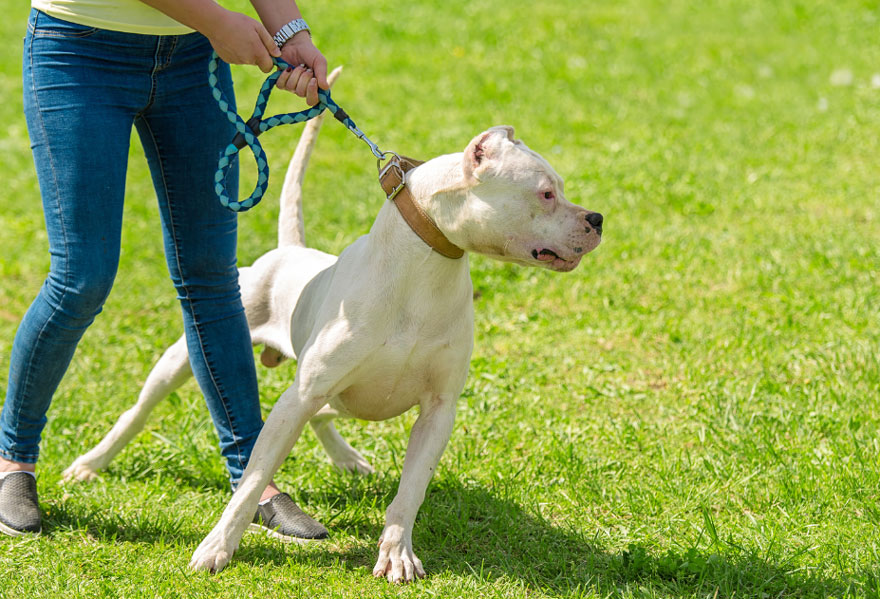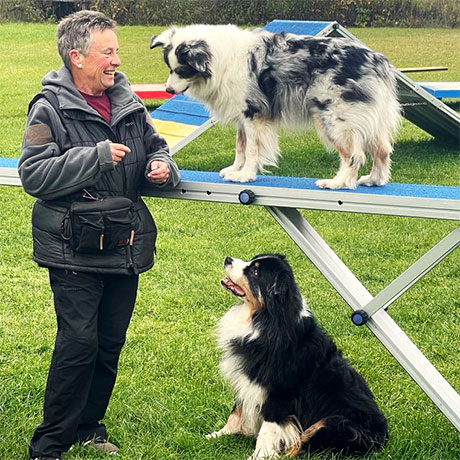8 Strategies You Should Not Use With Your Leash Reactive Dog
Leash reactivity is a common issue many dog owners face. It occurs when a dog displays behaviors such as barking, lunging, or growling when on a leash and encountering dogs, people, or things they find upsetting. While it can be frustrating, understanding what NOT to do is key to successfully managing and addressing leash reactivity.

1. Don’t Punish Your Dog
It can be tempting to correct your dog with harsh punishments, such as leash jerks, shouting, or using aversive tools like prong collars or shock collars. These actions, however, will just increase the reactivity in a dog who is already upset. Your dog’s behavior stems from a place of stress and fear or frustration so punishing them for reacting will only increase their negative emotions about the trigger.
Instead:
If your dog is reacting to a trigger punishment get them out of the situation as quickly as possible without punishment. If you cannot control your dog’s emotional responses near triggers you need to manage your walks to maintain distance from those triggers. If the dog is far enough away from the trigger to see it and still respond to you then use positive reinforcement for them being calm.
2. Don’t Force Interactions
One of the most common mistakes dog owners make is forcing their fear reactive dog to face the trigger head-on, thinking exposure will help them "get used to it." This is known as "flooding" and can be extremely overwhelming for your dog and can cause them to be “flooded” When a dog is flooded they may look perfectly fine but they have in fact shut down completely and are non-responsive. Forcing an anxious dog into situations they can’t handle may also escalate their fear.
Instead:
Allow your dog to approach triggers at their own pace, maintain a comfortable distance and leave the situation if they feel they need to. There are science based techniques that enable your dog to develop positive associations with the things that trigger their reactivity. You would most likely need a trainer to help you with these strategies.
3. Don’t Tighten the Leash
It’s natural to grip the leash tightly when your dog begins reacting, but doing so can actually increase their stress. Dogs are sensitive to leash tension, and a tight leash can signal to them that something is wrong. In the case of a fearful dog it can amplify their sense of danger. Tight leashes take all choice and control away from your dog which makes the situation even more upsetting for them.
Instead:
Try to leave your leash loose and stay as calm as possible. A relaxed leash encourages your dog to also remain calm and prevents interactions from escalating. Practicing loose leash handling skills when your dog is calm and in neutral environments can build your confidence, too.
4. Don’t Put Your Dog in Overwhelming Environments
Taking your leash-reactive dog to busy parks, dog events, or crowded urban settings might seem like a good opportunity for exposure, but these environments can be overwhelming. Too much exposure to triggers in too small a space will push your dog beyond their threshold causing them to react
Instead:
Choose environments where you have control over the level of exposure to triggers. Start in large quieter locations and gradually work up to more stimulating environments as your dog
5. Don’t Forget to Train Focus and Attention on You
Many leash-reactive dogs struggle with focus and impulse control. You can’t expect your dog to remain calm around triggers without teaching them an alternative behaviour to use such as focusing on you instead.
Instead:
Use activities that help your dog choose to focus on you in low-distraction environments and gradually increase the difficulty. This will help your dog learn to redirect their attention to you when a trigger appears.
6. Don’t Be Reactive Yourself
Dogs are highly attuned to their owner’s emotions and body language. If you are tense, anxious, or reactive during a walk, your dog will pick up on those signals, which can increase their own anxiety or reactivity.
Instead:
Stay calm and confident. By maintaining a relaxed demeanor, you signal to your dog that there’s nothing to worry about. Practice mindfulness techniques or breathing exercises to stay grounded during walks. Walk in areas where there are fewer triggers so you can both be more relaxed.
7. Don’t Expect Instant Results
Reducing leash reactivity requires patience and consistency over time. Many owners become discouraged when they don’t see immediate progress, causing them to give up or resort to harsher training methods. Change doesn’t happen overnight, especially when it involves modifying emotional responses and long-established habits.
Instead:
Celebrate small victories. Each time your dog remains calm in the presence of a trigger or improves their ability to focus on you, it's progress. Progress might be slow, but with time and builds confidence.
8. Don’t Ignore Professional Help
Leash reactivity can be a complex behavioral issue, and it may not be something you can tackle alone. Ignoring the problem or trying to manage it without proper guidance can lead to prolonged frustration and could possibly increase the reactivity.
Instead:
Seek help from a professional dog trainer or behaviorist who has experience working with leash-reactive dogs. They can provide you with a personalized training plan and help you understand your dog’s specific needs.
Conclusion
Leash reactivity can be challenging, but by avoiding common mistakes and focusing on positive, gradual training methods, you can help your dog become more comfortable and confident on walks. Patience, consistency, and understanding are the keys to success when working with a leash-reactive dog.
